Grazing in the Western United States Under Climate Change

Directional climate change and climate variability are making it harder for producers to graze cattle on rangeland and make a living. New research in Agrosystems, Geosciences & Environment highlights ways producers can tweak their operations to keep cattle on America’s valuable rangeland.
Cattle consume forage on landscapes that are otherwise hostile to cultivated agriculture—places like the shrubby sagebrush‐covered expanses of the Western states, the high‐country prairies in the upper Great Plains, and the sun‐soaked ranges of Texas and Oklahoma. Cattle dotted along federal and private rangeland often represent the livelihoods of those who could not farm row crops or vegetables, who work in conditions with far too little water for rainfed corn or soybean.
In America, a changing climate is clawing its way through the beef industry, upending routine production for producers whose families may have worked the land with their cows for decades or more. Increasing temperatures and unpredictable weather patterns are challenging the traditional method of grazing cattle by changing how much food is available for those cows on the landscape and whether the cattle can survive extended periods of unusually high or low temperatures.
What does beef production look like under a changing climate? A recent article published in Agrosystems, Geosciences & Environment (AGE) by a suite of researchers from across the western United States sought answers (https://doi.org/10.1002/agg2.20356). The authors, spanning Wyoming, Idaho, Colorado, and Nebraska, provided practical tips for grazing under climate change, hinging on flexibility and novel cooperation. Let’s dig in.
Beef Production
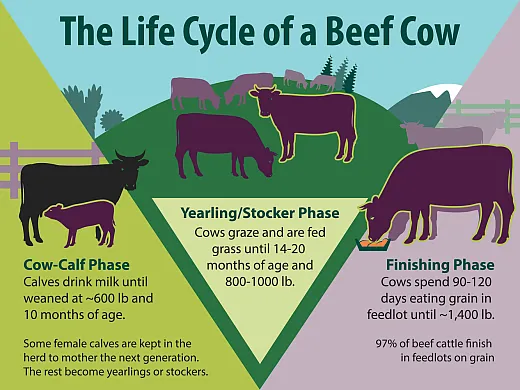
Of all agricultural land in the United States, grazing land makes up two‐thirds (http://bit.ly/489Jc0I). Rangeland—or land that supports natural, native ecosystems rather than highly maintained pastures—covers 21% of the U.S.’s surface area.
“Without ruminants, we could not make use of two‐thirds of all agricultural land,” says Frank Mitloehner, a University of California–Davis (UC‐Davis) professor and director of the CLEAR Center (who was not a coauthor on the AGE study). “What’s happening on that land is nothing short of a miracle because [ruminants] can take something nobody else can digest and convert it into food we highly desire.”
In the United States, beef production starts with cow‐calf operations. Ideally, every year, a mother cow gives birth to a calf weighing somewhere between 60 and 100 lb. Kept in cow‐calf pairs, ranchers send the cows out on grazing land where the mother cow feeds on forage and the calf drinks mother’s milk for the first eight or nine months of its life. Then the rancher weans the calves when they’re about 600 lb. Some female calves (usually about a third) are kept, becoming mother cows the next year; the rest are sent out in their own herds and called yearlings or stockers.
Yearlings feed on forages until they reach 800 to 1000 lb between 14 and 20 months of age. At this point, 97% of cattle are sold by producers to feedlots for a final “finishing” or “feeding” phase where they are fed grain instead of grass until they reach a desired finished weight, averaging about 1,400 lb before harvest. The diet change from grass to grain gives beef its distinctive marbling. The more marbling, the higher the USDA grade of beef (https://bit.ly/3P2y1OM).
“Your whole livelihood depends on whether or not, on that day, your cattle sell well,” says Justin Derner, co‐author of the AGE study and rangeland scientist for the USDA‐ARS High Plains Grasslands Research Station in Cheyenne, WY. The economic inputs for producers are myriad—selling price and input costs are often out of their control. “There’s no guaranteed check every year or every month, and you don’t control your input costs—feed supply, interest rates, gas prices.”
Nor do you control the weather.
Changing Climate, Changing Production
Climate change is pushing temperatures to extremes. Seasonal patterns producers may have observed for decades are shifting, and those shifts wreak havoc on producers’ routines. In scientific parlance, climate change is causing both directional change and climatic variability. Directional climate change sees warmer‐than‐average temperatures with a greater number of days at high temperatures. Growing season changes, heat stress, and changing plant life cycles are all impacting the beef sector. Climatic variability describes how the climate differs from the average in both temperature and precipitation.
“Spring is coming earlier, plants are maturing earlier,” Derner says. “Timing is critical. If you want to start sending cows out earlier, there could be some grass out there.”
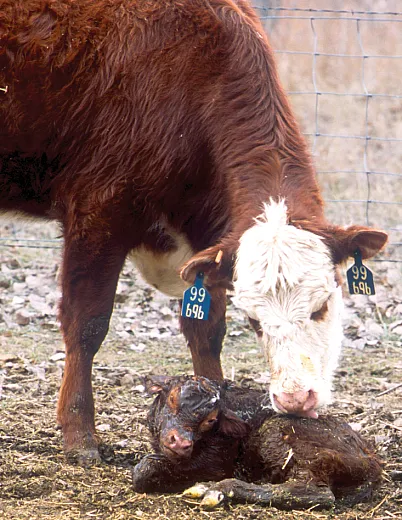
Sending cattle to graze on rangeland means relying on the natural composition of plant species to provide enough forage for cattle to grow. In wetter seasons, forage may be abundant, which reduces the need to move cattle as frequently to prevent overgrazing or to provide them with enough feed. In drought conditions, producers may need to rotate cattle more frequently or supplement with hay harvested and stored from some other time and place.
But changing temperatures are a boon for more than desirable forage. Invasive plant species like cheatgrass and larkspur are creeping onto rangelands. These species don’t just take over good forages, but larkspur may even be toxic when ingested by cattle. If producers fail to take poisonous plants into account, cattle can die.
Plus, there’s the “summer slump” to think about. Once a plant puts seedheads out, the quality of the plant as forage drops markedly. At a time when you’d most expect there to be healthy, thriving plants for cattle to eat, you see instead a drop in nutrition. This can mean cattle fail to “bulk up” as much, despite what appears to be abundant food. Producers may need to give their animals supplemental rations or protein during a summer slump, but that can present logistical challenges.
When cattle graze on rangeland, they cover massive areas—hundreds or thousands of acres, in many cases. Though they tend to stay in a herd, physically going to cattle to provide them with feed or supplements on a weekly or daily basis is a huge addition of time and labor for producers.
Think like a producer for a second: your livelihood depends on maximizing the pounds of weight your cattle gain relative to the amount of feed they take in. The single greatest cost you have is for feed. If there’s not enough on rangelands for the cattle to eat, you’ll spend more on feed. If rangeland forage is abundant, your feed costs will be lower. Finally, when you sell your stocker cattle at market, the prices they fetch are in some ways tied to the cost of grain.
“You can produce the best animals in the world, but if there’s a major drought in the corn‐producing region, that’s going to impact who’s going to buy your cattle and what they’re going to do with them,” Derner says.
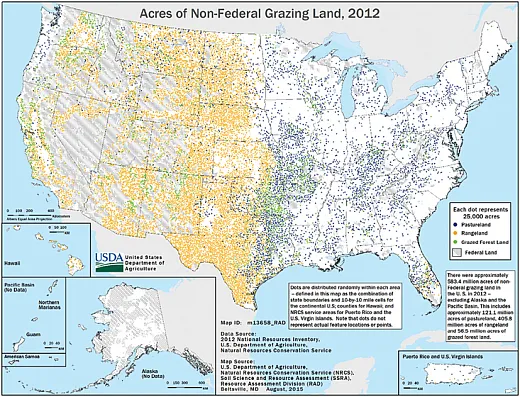
What can producers do?
Flexibility
In their study in AGE, Derner and his colleagues recommend flexibility for an industry that relies on historic practices tied closely to social and economic considerations.

There are many reasons for this: producers have been working for years, perhaps decades, to cultivate a herd of cattle that produces consistent, fine results. The infrastructure of beef production shelters cow‐calf operations at its heart. Cow‐calf operators strive to produce animals that give both stocker and feed yards animals that are healthy, disease‐free, and produce high quality beef. It’s a matter of reputation more than anything.
“You have a certain base caliber of animal you need to operate, and your livelihood depends on it,” Derner says. Because reputation is such a big factor in making sales, producers may be hesitant to change their herds—they might not want to cull animals in tough years or try to buy more animals when forage is abundant, even if it means they may take a hit to their profits or lose out on selling more cattle at higher prices in good years. Plus, everyone else may be trying the same thing. Prices to buy new cattle are often at their highest when producers can least afford those prices.
An illustration: During a drought year, producers may cut their losses by decreasing their herd size. Fewer mouths to feed mean buying less feed and making more efficient use of the forage available. Perhaps the drought breaks the next year, and there’s much more forage available on the rangeland a producer uses to feed their cows—they may be tempted to buy more cattle, but prices for those cows will be much higher.
Says Derner, “It’s often simpler to stay the course.”
Another hitch: The cows can feel like family. It could be that a producer’s mom, dad, uncle, or grandparents, worked for years to find the perfect fit between the cattle they raise and their environment, so getting rid of those cows can be emotional. Likewise, there’s the matter of genetic fit. Cows born and bred at elevation in Wyoming will likely perform better than a new batch of cows brought in from the Great Plains—in much the same way that runners from Denver, CO tend to have the advantage when competing with athletes from coastal states at elevation.
With these rigid constraints, introducing flexibility is a big ask.
Under directional climate change, prolonged heat stress is a major factor limiting how well cows perform. Moving cattle at different times—or even to new locations—could help overcome directional climate change. Derner and his coauthors recommend moving cattle to higher elevations as it gets warmer to reduce heat stress. However, this option is not available to producers whose grazing land does not include a wide range of environments. Even if a producer has 10,000 acres, if all those acres are at about the same elevation with the same plant species, their ability to move cattle to overcome directional climate change is limited.

There are three broad ways to handle this. The first is keeping supplemental feed for times of need. Haying a standing crop of forages to put in feed stores is one option if there are pastures or fields of forage available to hay. On rangelands, a producer could interseed legume forages if forage quality is low, but maintaining those forages can be tough.
The second option is introducing flexibility in the operation itself to make conditions more favorable and profitable. Many cow‐calf operations “calve” in the spring, timing the pregnancies of their mother cows to coincide with better weather and better forage availability. With changing climate, shifting calving to another time that makes more sense for their operation could help them make the best possible use of forage when it’s available. Another option is introducing flexible stocking rates based on predictions about the upcoming year’s forage quality. For the reasons outlined above, producers are very invested in the animals they have on their farm—flexible stocking rates could be a tough sell.
The third, and most radical, option is to adopt a system like that used in Australia, in which cattle are moved across very wide ranges to make the best possible use of seasonal environmental conditions. Cattle could spend the winter months in the southern U.S., moving northward as the weather warms to make use of growing forage and prevent heat stress. There are trade‐offs, of course—cattle would have to be managed in a cooperative, over many different producers’ lands, with a great deal of transportation in the mix. Cattle can be shipped via train or semi‐truck, and the process can add additional stress on animals. These are all kinks the industry (and researchers) need to work out.
“From the science side, we can study [the impacts of climate] all we want, but if solutions don’t work practically on the ground, we’re not going to get producers taking up those solutions,” Derner says. “We need to be fair, open, and transparent with producers about that.”
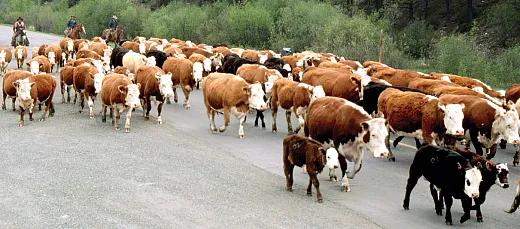
Questions of Sustainability
Animal agriculture often gets a bad rap for its environmental impact. The oft‐cited statistic shows that livestock emit 4% of all greenhouse gases in the United States (https://bit.ly/463JULb). Most of those emissions are in the form of methane from cattle burps, which is shorter‐lived than carbon dioxide (lasting a mere decade in the atmosphere) but about 30 times as potent in its global warming potential.
While there are myriad opportunities for producers to reduce methane emissions, America has one of the most efficient beef production systems in the world.
“In the United States, we’re producing 18% of the world’s global beef supply with 6% of the global beef cattle,” Mitloehner says. “We have, globally, the most efficient way of producing beef—nobody produces more beef than we do with fewer animals.”
One major source of this efficiency comes from a place you wouldn’t necessarily intuit: the feedlot.
When ruminants like cows feed on grass, their gut microbiome converts a great deal of the energy they receive from food into methane—as much as 12% of the animals’ consumed energy is lost as methane, rather than kept on the animal as muscle or fat gain (https://bit.ly/3PuWjCj). As cows are fed more grain, the amount of methane produced in the rumen decreases (https://bit.ly/3sTz6Be).
Feedlot cattle are often fed corn and corn by‐products from distillation or other food‐manufacturing processes, like distiller’s grain. Without cattle to eat these waste products, distiller’s grain would end up in the landfill, Mitloehner explains. Plus, cattle finished on high‐energy grain diets at feedlots gain weight much more quickly than those reared on grass alone, belching less methane than if they lived for another year or two to reach market weight.
Since the 1970s, beef producers have made great strides in genetic selection to reduce the impact of beef production, as well. They’ve bred cattle to gain much more efficiently and improved ration nutrition to help decrease the amount of feed necessary to reach market weight. In the 1970s, according to UC‐Davis, we needed 140 million head of cattle to meet market demands for beef. Now, just 90 million head are producing more meat (https://bit.ly/463JULb).
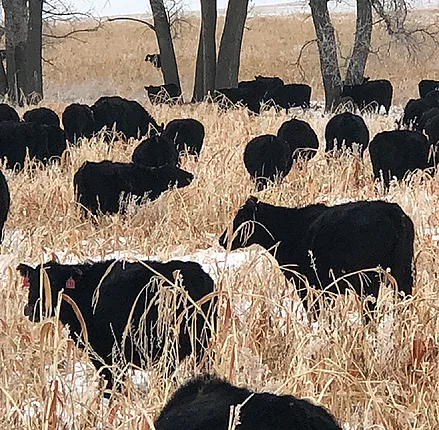
There’s room for improvement, of course.
Multiple studies have documented the benefits of bringing livestock onto cropland in what is known as an “integrated crop–livestock system” (https://doi.org/10.1002/csan.20491). Grazing crop residues or cover crops with livestock makes efficient use of unharvested plant matter by turning it into livestock feed without the hassle of baling or storing it. This practice also has demonstrated benefits in improving soil carbon and soil health over time, particularly in areas where agricultural lands were once native grasslands (https://bit.ly/3ZflKv8).
Randy Jackson, a member of ASA, CSSA, and SSSA and professor at University of Wisconsin–Madison, sees the restoration of cropland to grazed permanent pasture in the upper Midwest as key to mitigating the impact of livestock production on climate change. In a recent paper published in Agricultural & Environmental Letters, Jackson and his coauthors, Abby Augarten et al., found that biological indicators of soil health and soil organic matter were up to 195% greater in pastures than other cropping systems (https://doi.org/10.1002/ael2.20100). Jackson argues emphatically for a return of cropland used to grow feed for cattle to perennial pasture that cattle can graze, instead.
“I think we can, generally speaking, offset most methane emissions by carbon‐building soils in the upper Midwest with well‐managed rotational grazing,” Jackson says, qualifying that this is most likely to occur in areas with greater annual precipitation. “Restoring grassland function is one way to do that, and it’s essential to addressing humanity’s four grand challenges: Biodiversity decline, resource degradation, social inequality, and climate change.”
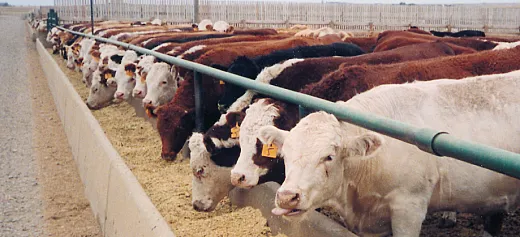
Converting cropland to pasture is an option only in places where the land is viable for crops in the first place, though. For many of the ranchers and producers working on rangeland in the western United States, most of their land is suitable for well‐managed grazing, including cattle, bison, and sheep.
The next great frontier in animal agriculture may be a shift in the production system we’ve developed over the past half century; or it may be tweaks, big and small, to genetics, feed supplements, and producer’s routines that help maintain cattle grazing in a changing climate. One thing is certain: forming new relationships between one rancher and another, as well as between researchers and society at large, will be critical in bringing change to a key system of production on two‐thirds of all our agricultural land.
DIG DEEPER
Augarten, A. J., Malone, L. C., Richardson, G. S., Jackson, R. D., Wattiaux, M. A., Conley, S. P., … & Ruark, M. D. (2023). Cropping systems with perennial vegetation and livestock integration promote soil health. Agricultural & Environmental Letters, 8, e20100. https://doi.org/10.1002/ael2.20100
Derner, J. D., Wilmer, H., Stackhouse‐Lawson, K., Place, S., & Boggess, M. (2023). Practical considerations for adaptive strategies by US grazing land managers with a changing climate. Agrosystems, Geosciences & Environment, 6, 1–13. https://doi.org/10.1002/agg2.20356
McCauley, DJ. (2021). Bringing cattle onto cropland in the Northern Great Plains. CSA News, 66(6), 3–9. https://doi.org/10.1002/csan.20491
Text © . The authors. CC BY-NC-ND 4.0. Except where otherwise noted, images are subject to copyright. Any reuse without express permission from the copyright owner is prohibited.










